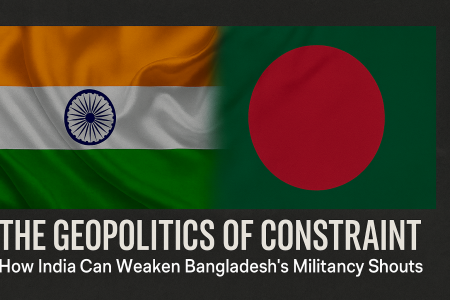| নির্বাচিত পোস্ট | লগইন | রেজিস্ট্রেশন করুন | রিফ্রেস |
 রেজাউল করিম ফকির
রেজাউল করিম ফকির
অধ্যাপক, কোবে গাকুইন বিশ্ববিদ্যালয়

1. Introduction
In the post-2024 geopolitical landscape, Bangladesh has witnessed the resurgence of anti-establishment voices, some of which have taken on militant forms under the banner of ideological or revolutionary change. These “militancy shouts,” whether rooted in political extremism or armed dissent, pose a challenge not only to Bangladesh’s internal stability but also to the strategic balance in South Asia. India, as a regional hegemon with shared history, geography, and security interests, may see the containment of such militancy as a geopolitical necessity. This essay explores how India—through short-term and long-term, overt and covert strategies—can strategically suppress Bangladesh’s rising militant voices by undermining the infrastructural and ideological environments that enable their growth. Special attention is paid to trade embargoes, diplomatic isolation, and movement restrictions via Indian territory.
2. Understanding the Roots of Militancy Shouts**
The rise of militant expressions in Bangladesh stems from a combination of:
Economic marginalization, particularly among the youth and rural poor.
Political repression and lack of democratic space.
Religious and ideological polarization, often manipulated by transnational networks.
Weak border security and informal arms trafficking.
India views such developments not only as internal Bangladeshi issues but also as threats with cross-border implications, especially in its Northeast.
3. Short-term Measures to Disrupt Militancy Network
A. Overt Actions
i. Trade Embargoes and Tariff Measures
India can impose targeted trade restrictions on sectors or regions suspected of financing or sheltering radical networks. Blocking cross-border trade via Benapole–Petrapole or Akhaura–Agartala could have immediate psychological and economic effects in border districts.
ii. Suspension of Transit Privileges
Revoking transit facilities for Bangladeshi goods through Indian land, riverine, or airspace routes—especially those connected to Bhutan and Nepal—could choke economic circulation and mobility in affected areas, indirectly pressuring militant-harboring zones.
iii. Border Surveillance Intensification
Deploying enhanced surveillance technologies, drone patrols, and military fencing at key infiltration points can curb the movement of people and arms that fuel underground militant groups.
B. Covert Actions
i. Intelligence Disruption Campaigns
India’s RAW (Research and Analysis Wing) could conduct cyber-infiltration into militant digital networks to dismantle propaganda mechanisms and funding channels.
ii. Controlled Disinformation
Strategically placed disinformation targeting militant ideologues could delegitimize their narratives, breed internal division, and erode public sympathy.
iii. Selective Sponsorship of Moderate Counter-Movements
Through cultural and media outreach, India can indirectly promote moderate, pluralistic movements within Bangladesh that weaken the appeal of militant ideologies.
4. Long-term Structural Measures
A. Overt Actions
i. Strategic Isolation in International Forums
India can work with allies like the U.S., EU, or ASEAN to diplomatically corner Bangladesh if militancy is seen as state-tolerated or incompetently handled. This could include arms embargoes or visa restrictions against suspect institutions.
ii. Water and Connectivity Pressure
Using control over river systems (e.g., Teesta) and road corridors, India can periodically withhold concessions until Bangladesh tightens its internal control over radical enclaves.
iii. Economic Dependency Engineering
Long-term dependence on Indian connectivity and electricity grids may allow India to dictate political behavior, including counter-militancy policies.
B. Covert Actions
i. Ideological Subversion
Undermining madrasa radicalism by promoting moderate curricula or influencing digital theological spaces in Bangladesh via proxies or NGOs.
ii. Surveillance Infiltration
Recruiting assets within militant-leaning zones or religious-political parties can provide actionable intelligence for both India and Bangladesh to suppress extremism from within.
iii. Regional Proxy Engagement
Strengthening ties with countries like Myanmar or Bhutan to create a regional anti-militancy consensus that diplomatically isolates any tolerance of extremism within Bangladesh.
-5. Strategic Implications and Risks**
Despite strategic advantages, these actions pose several risks:
Public backlash in Bangladesh could rally anti-India sentiments and drive more youth toward militancy.
Destabilizing Northeast India, especially if cross-border kin groups (e.g., Tripuri, Khasi, or Chakma) perceive Indian policy as ethnically biased.
International condemnation, particularly from OIC or China, if India is perceived as overreaching.
Therefore, any move must be calibrated with strategic subtlety and multilateral coordination.
6. Conclusion
Suppressing militancy in a neighboring state requires more than military posturing—it demands the manipulation of economic levers, ideological ecosystems, and regional alliances. India’s geopolitical calculus vis-à-vis Bangladesh’s militant outbursts must involve a combination of overt statecraft and covert influence, aimed not just at crushing insurgency but at uprooting the socio-political conditions that allow militancy to thrive. If strategically executed, such a campaign could serve India's security objectives while reshaping the subcontinent’s balance of ideological and military power.
©somewhere in net ltd.